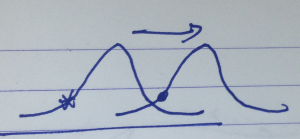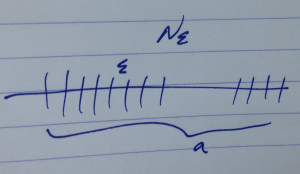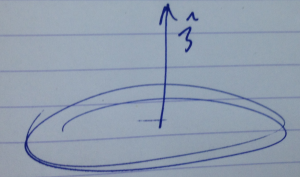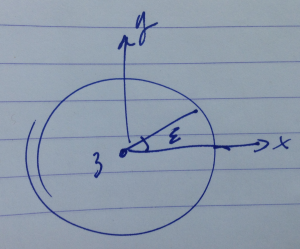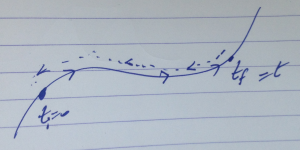[Click here for a PDF of this post with nicer formatting]
Disclaimer
Peeter’s lecture notes from class. These may be incoherent and rough.
These are notes for the UofT course PHY1520, Graduate Quantum Mechanics, taught by Prof. Paramekanti, covering \textchapref{{4}}, \textchapref{{3}} [1] content.
Time reversal (cont.)
Given a time reversed state
\begin{equation}\label{eqn:qmLecture13:20}
\ket{\tilde{\Psi}(t)} = \Theta \ket{\Psi(0)}
\end{equation}
which can alternately be written
\begin{equation}\label{eqn:qmLecture13:40}
\Theta^{-1} \ket{\tilde{\Psi}(t)} = \ket{\Psi(-t)} = e^{i \hat{H} t/\Hbar} \ket{\Psi(0)}
\end{equation}
The left hand side can be expanded as the evolution of the state as found at time \( -t \)
\begin{equation}\label{eqn:qmLecture13:60}
\begin{aligned}
\Theta^{-1} \ket{\tilde{\Psi}(t)}
&=
\Theta^{-1} e^{-i \hat{H} t/\Hbar} \ket{\tilde{\Psi}(-t)} \\
&=
\Theta^{-1} e^{-i \hat{H} t/\Hbar} \Theta \ket{\Psi(0)}.
\end{aligned}
\end{equation}
To first order for a small time increment \( \delta t \), we have
\begin{equation}\label{eqn:qmLecture13:80}
\lr{ 1 + i \frac{\hat{H}}{\Hbar} \delta t } \ket{\Psi(0)} =
\Theta^{-1} \lr{ 1 – i \frac{\hat{H}}{\Hbar} \delta t } \Theta \ket{\Psi(0)},
\end{equation}
or
\begin{equation}\label{eqn:qmLecture13:120}
i \frac{\hat{H}}{\Hbar} \delta t \ket{\Psi(0)}
=
\Theta^{-1} (- i) \frac{\hat{H}}{\Hbar} \delta t \Theta \ket{\Psi(0)}.
\end{equation}
Since this holds for any state \( \ket{\Psi(0)} \), the time reversal operator satisfies
\begin{equation}\label{eqn:qmLecture13:140}
i \hat{H}
=
\Theta^{-1} (- i) \hat{H} \Theta.
\end{equation}
Note that the factors of \( i \) have not been canceled on purpose, since we are allowing for the time reversal operator to not necessarily commute with imaginary numbers.
There are two possible solutions
- If \( \Theta \) is unitary where \( \Theta i = i \Theta \), then
\begin{equation}\label{eqn:qmLecture13:160}
\hat{H}
=
-\Theta^{-1} \hat{H} \Theta,
\end{equation}
or
\begin{equation}\label{eqn:qmLecture13:180}
\Theta \hat{H}
=
– \hat{H} \Theta.
\end{equation}
Consider the implications of this on energy eigenstates
\begin{equation}\label{eqn:qmLecture13:200}
\hat{H} \ket{\Psi_n} = E_n \ket{\Psi_n},
\end{equation}
\begin{equation}\label{eqn:qmLecture13:220}
\Theta \hat{H} \ket{\Psi_n} = E_n \Theta \ket{\Psi_n},
\end{equation}
but
\begin{equation}\label{eqn:qmLecture13:240}
-\hat{H} \Theta \ket{\Psi_n} = E_n \Theta \ket{\Psi_n},
\end{equation}
or
\begin{equation}\label{eqn:qmLecture13:260}
\hat{H} \lr{ \Theta \ket{\Psi_n}} = -E_n \lr{ \Theta \ket{\Psi_n} }.
\end{equation}
This would mean that \( \lr{ \Theta \ket{\Psi_n}} \) is an eigenket of \( \hat{H} \), but with a negative energy eigenvalue.
- \( \Theta \) is antiunitary, where \( \Theta i = -i \Theta \).
This time
\begin{equation}\label{eqn:qmLecture13:280}
i \hat{H} = i \Theta^{-1} \hat{H} \Theta,
\end{equation}
so
\begin{equation}\label{eqn:qmLecture13:300}
\Theta \hat{H} = \hat{H} \Theta.
\end{equation}
Acting on an energy eigenket, we’ve got
\begin{equation}\label{eqn:qmLecture13:1400}
\Theta \hat{H} \ket{\Psi_n}
=
E_n \lr{ \Theta \ket{\Psi_n} },
\end{equation}
and
\begin{equation}\label{eqn:qmLecture13:1420}
\lr{ \hat{H} \Theta } \ket{\Psi_n}
=
\hat{H} \lr{ \Theta \ket{\Psi_n} },
\end{equation}
so \( \Theta \ket{\Psi_n} \) is an eigenstate with energy \( E_n \).
What properties do we expect from \( \Theta \)?
We expect
\begin{equation}\label{eqn:qmLecture13:320}
\begin{aligned}
\hat{x} &\rightarrow \hat{x} \\
\hat{p} &\rightarrow -\hat{p} \\
\hat{\BL} &\rightarrow -\hat{\BL}
\end{aligned}
\end{equation}
where we have a sign flip in the time dependent momentum operator (and therefore angular momentum), but not for position. If we have
\begin{equation}\label{eqn:qmLecture13:340}
\Theta^{-1} \hat{x} \Theta = \hat{x},
\end{equation}
if that’s true, then how about the momentum operator in the position basis
\begin{equation}\label{eqn:qmLecture13:360}
\begin{aligned}
\Theta^{-1} \hat{p} \Theta
&=
\Theta^{-1} \lr{ -i \Hbar \PD{x}{} } \Theta \\
&=
\Theta^{-1} \lr{ -i \Hbar } \Theta \PD{x}{} \\
&=
i \Hbar \Theta^{-1} \Theta \PD{x}{} \\
&=
-\hat{p}.
\end{aligned}
\end{equation}
How about the \( x,p \) commutator? For that we have
\begin{equation}\label{eqn:qmLecture13:380}
\begin{aligned}
\Theta^{-1} \antisymmetric{\hat{x}}{\hat{p}} \Theta
&=
\Theta^{-1} \lr{ i \Hbar } \Theta \\
&=
-i \Hbar \Theta^{-1} \Theta \\
&=
– \antisymmetric{\hat{x}}{\hat{p}}.
\end{aligned}
\end{equation}
For the the angular momentum operators
\begin{equation}\label{eqn:qmLecture13:420}
\hat{L}_i = \epsilon_{ijk} \hat{r}_j \hat{p}_k,
\end{equation}
the time reversal operator should flip the sign due to its action on \( \hat{p}_k \).
Time reversal acting on spin 1/2 (Fermions). Attempt I.
Consider two spin states \( \ket{\uparrow}, \ket{\downarrow} \). What should the action of the time reversal operator on such a state be? Let’s (incorrectly) start by supposing that the time reversal operator effects are
\begin{equation}\label{eqn:qmLecture13:440}
\begin{aligned}
\Theta \ket{\uparrow} &= \ket{\downarrow} \\
\Theta \ket{\downarrow} &= \ket{\uparrow}.
\end{aligned}
\end{equation}
Given a general state
so that if
\begin{equation}\label{eqn:qmLecture13:740}
\ket{\Psi} = a \ket{\uparrow} + b \ket{\downarrow},
\end{equation}
the action of the time reversal operator would be
\begin{equation}\label{eqn:qmLecture13:760}
\Theta \ket{\Psi} = a^\conj \ket{\downarrow} + b^\conj \ket{\uparrow}.
\end{equation}
That action is:
\begin{equation}\label{eqn:qmLecture13:460}
\begin{aligned}
a \rightarrow b^\conj \\
b \rightarrow a^\conj
\end{aligned}
\end{equation}
Let’s consider whether or not such an action a spin operator with properties
\begin{equation}\label{eqn:qmLecture13:480}
\antisymmetric{\hat{S}_i}{\hat{S}_j} = i \epsilon_{ijk} \hat{S}_k.
\end{equation}
produce the desired inversion of sign
\begin{equation}\label{eqn:qmLecture13:500}
\Theta^{-1} \hat{S}_i \Theta = – \hat{S}_i.
\end{equation}
The expectations of the spin operators (without any application of time reversal) are
\begin{equation}\label{eqn:qmLecture13:1440}
\begin{aligned}
\bra{\Psi} \hat{S}_x \ket{\Psi}
&=
\frac{\Hbar}{2}
\lr{ a^\conj \bra{\uparrow} + b^\conj \bra{\downarrow} }
\sigma_x
\lr{ a \ket{\uparrow} + b \ket{\downarrow} } \\
&=
\frac{\Hbar}{2}
\lr{ a^\conj \bra{\uparrow} + b^\conj \bra{\downarrow} }
\lr{ a \ket{\downarrow} + b \ket{\uparrow} } \\
&=
\frac{\Hbar}{2}
\lr{ a^\conj b + b^\conj a },
\end{aligned}
\end{equation}
\begin{equation}\label{eqn:qmLecture13:1460}
\begin{aligned}
\bra{\Psi} \hat{S}_y \ket{\Psi}
&=
\frac{\Hbar}{2}
\lr{ a^\conj \bra{\uparrow} + b^\conj \bra{\downarrow} }
\sigma_y
\lr{ a \ket{\uparrow} + b \ket{\downarrow} } \\
&=
\frac{i\Hbar}{2}
\lr{ a^\conj \bra{\uparrow} + b^\conj \bra{\downarrow} }
\lr{ a \ket{\downarrow} – b \ket{\uparrow} } \\
&=
\frac{\Hbar}{2 i} \lr{ a^\conj b – b^\conj a },
\end{aligned}
\end{equation}
\begin{equation}\label{eqn:qmLecture13:1480}
\begin{aligned}
\bra{\Psi} \hat{S}_z \ket{\Psi}
&=
\frac{\Hbar}{2}
\lr{ a^\conj \bra{\uparrow} + b^\conj \bra{\downarrow} }
\sigma_z
\lr{ a \ket{\uparrow} – b \ket{\downarrow} } \\
&=
\frac{\Hbar}{2} \lr{ \Abs{a}^2 – \Abs{b}^2 }
\end{aligned}
\end{equation}
The time reversed actions are
\begin{equation}\label{eqn:qmLecture13:1560}
\begin{aligned}
\bra{\Psi} \Theta^{-1} \hat{S}_x \Theta \ket{\Psi}
&=
\frac{\Hbar}{2}
\lr{ a^\conj \bra{\downarrow} + b^\conj \bra{\uparrow} }
\sigma_x
\lr{ a \ket{\downarrow} + b \ket{\uparrow} } \\
&=
\frac{\Hbar}{2}
\lr{ a^\conj \bra{\downarrow} + b^\conj \bra{\uparrow} }
\lr{ a \ket{\uparrow} + b \ket{\downarrow} } \\
&=
\frac{\Hbar}{2}
\lr{ a^\conj b + b^\conj a },
\end{aligned}
\end{equation}
\begin{equation}\label{eqn:qmLecture13:1580}
\begin{aligned}
\bra{\Psi} \Theta^{-1} \hat{S}_y \Theta \ket{\Psi}
&=
\frac{\Hbar}{2}
\lr{ a^\conj \bra{\downarrow} + b^\conj \bra{\uparrow} }
\sigma_y
\lr{ a \ket{\downarrow} + b \ket{\uparrow} } \\
&=
\frac{i\Hbar}{2}
\lr{ a^\conj \bra{\downarrow} + b^\conj \bra{\uparrow} }
\lr{ -a \ket{\uparrow} + b \ket{\downarrow} } \\
&=
\frac{\Hbar}{2 i} \lr{ -a^\conj b + b^\conj a },
\end{aligned}
\end{equation}
\begin{equation}\label{eqn:qmLecture13:1600}
\begin{aligned}
\bra{\Psi} \Theta^{-1} \hat{S}_z \Theta \ket{\Psi}
&=
\frac{\Hbar}{2}
\lr{ a^\conj \bra{\downarrow} + b^\conj \bra{\uparrow} }
\sigma_z
\lr{ a \ket{\downarrow} + b \ket{\uparrow} } \\
&=
\frac{\Hbar}{2}
\lr{ a^\conj \bra{\downarrow} + b^\conj \bra{\uparrow} }
\lr{ -a \ket{\downarrow} + b \ket{\uparrow} } \\
&=
\frac{\Hbar}{2} \lr{ -\Abs{a}^2 + \Abs{b}^2 }
\end{aligned}
\end{equation}
We see that this is not right, because the sign for the x component has not been flipped.
Spin 1/2 (Fermions). Attempt II.
Again assuming
\begin{equation}\label{eqn:qmLecture13:580}
\ket{\Psi} = a \ket{\uparrow} + b \ket{\downarrow},
\end{equation}
now try the action
\begin{equation}\label{eqn:qmLecture13:780}
\Theta \ket{\Psi} = a^\conj \ket{\downarrow} – b^\conj \ket{\uparrow}.
\end{equation}
This is the action:
\begin{equation}\label{eqn:qmLecture13:600}
\begin{aligned}
a \rightarrow -b^\conj \\
b \rightarrow a^\conj
\end{aligned}
\end{equation}
The correct action of time reversal on the basis states (up to a phase choice) is
\begin{equation}\label{eqn:qmLecture13:630}
\boxed{
\begin{aligned}
\Theta \ket{\uparrow} &= \ket{\downarrow} \\
\Theta \ket{\downarrow} &= -\ket{\uparrow} \\
\end{aligned}
}
\end{equation}
Note that acting the time reversal operator twice has the effects
\begin{equation}\label{eqn:qmLecture13:660}
\Theta^2 \ket{\uparrow} = \Theta \ket{\downarrow} = – \ket{\uparrow}
\end{equation}
\begin{equation}\label{eqn:qmLecture13:680}
\Theta^2 \ket{\downarrow} = \Theta (-\ket{\uparrow}) = – \ket{\uparrow}.
\end{equation}
We end up with the same state we started with, but with the opposite sign. This means that as an operator
\begin{equation}\label{eqn:qmLecture13:700}
\boxed{
\Theta^2 = -1.
}
\end{equation}
This is try for half integer particles (Fermions) \( S = 1/2, 3/2, 5/2, \cdots \), but for Bosons with integer spin \( S \).
\begin{equation}\label{eqn:qmLecture13:720}
\boxed{
\Theta^2 = 1.
}
\end{equation}
Kramer’s degeneracy for Spin 1/2 (Fermions)
Suppose we imagine there is state for which the action of the time reversal operator products the same state, just different in phase
\begin{equation}\label{eqn:qmLecture13:800}
\begin{aligned}
\Theta \ket{\Psi_n}
&= \ket{\tilde{\Psi}_n} \\
&= e^{i \delta} \ket{\tilde{\Psi}_n},
\end{aligned}
\end{equation}
then
\begin{equation}\label{eqn:qmLecture13:840}
\begin{aligned}
\Theta^2 \ket{\Psi_n}
&= \Theta e^{i \delta} \ket{\tilde{\Psi}_n} \\
&= e^{i \delta} e^{i \delta} \ket{\tilde{\Psi}_n},
\end{aligned}
\end{equation}
but
\begin{equation}\label{eqn:qmLecture13:860}
\begin{aligned}
\Theta e^{i \delta} \ket{\tilde{\Psi}_n}
&=
e^{-i \delta} \Theta \ket{\tilde{\Psi}_n} \\
&=
e^{-i \delta} e^{i \delta} \ket{\tilde{\Psi}_n} \\
&=
\ket{\tilde{\Psi}_n}
\ne
– \ket{\tilde{\Psi}_n}.
\end{aligned}
\end{equation}
This is a contradiction, so we must have at least a two-fold degeneracy. This is called Kramer’s degeneracy. In the homework we will show that this is not the case for integer spin particles.
Angular momentum
In classical mechanics the (orbital) angular momentum is
\begin{equation}\label{eqn:qmLecture13:880}
\BL = \Br \cross \Bp.
\end{equation}
Here “orbital” is to distinguish from spin angular momentum.
In quantum mechanics, the mapping to operators, in component form, is
\begin{equation}\label{eqn:qmLecture13:900}
\hat{L}_i = \epsilon_{ijk} \hat{r}_j \hat{p}_k.
\end{equation}
These operators do not commute
\begin{equation}\label{eqn:qmLecture13:920}
\antisymmetric{\hat{L}_i}{\hat{L}_j}
=
i \Hbar \epsilon_{ijk} \hat{L}_k.
\end{equation}
which means that we can’t simultaneously determine \( \hat{L}_i \) for all \( i \).
Aside: In quantum mechanics, we define an operator \( \hat{\BV} \) to be a vector operator if
\begin{equation}\label{eqn:qmLecture13:940}
\antisymmetric{\hat{L}_i}{\hatV_j}
=
i \Hbar \epsilon_{ijk} \hatV_k.
\end{equation}
The commutator of the squared angular momentum operator with any \( \hat{L}_i \), say \( \hat{L}_x \) is zero
\begin{equation}\label{eqn:qmLecture13:960}
\begin{aligned}
\antisymmetric{
\hat{L}_x^2 +
\hat{L}_y^2 +
\hat{L}_z^2
}
{\hat{L}_x}
&=
\hat{L}_y \hat{L}_y \hat{L}_x
– \hat{L}_x \hat{L}_y \hat{L}_y
+
\hat{L}_z \hat{L}_z \hat{L}_x
– \hat{L}_x \hat{L}_z \hat{L}_z \\
&=
\hat{L}_y \lr{ \antisymmetric{\hat{L}_y}{\hat{L}_x} + {\hat{L}_x \hat{L}_y} }
-\lr{ \antisymmetric{\hat{L}_x}{\hat{L}_y} + {\hat{L}_y \hat{L}_x} } \hat{L}_y \\
&\quad +\hat{L}_z \lr{ \antisymmetric{\hat{L}_z}{\hat{L}_x} + {\hat{L}_x \hat{L}_z} }
-\lr{ \antisymmetric{\hat{L}_x}{\hat{L}_z} + {\hat{L}_z \hat{L}_x} } \hat{L}_z \\
&=
\hat{L}_y \antisymmetric{\hat{L}_y}{\hat{L}_x}
-\antisymmetric{\hat{L}_x}{\hat{L}_y} \hat{L}_y
+\hat{L}_z \antisymmetric{\hat{L}_z}{\hat{L}_x}
-\antisymmetric{\hat{L}_x}{\hat{L}_z} \hat{L}_z \\
&=
i \Hbar \lr{
-\hat{L}_y \hat{L}_z
– \hat{L}_z \hat{L}_y
+\hat{L}_z \hat{L}_y
+ \hat{L}_y \hat{L}_z
} \\
&=
0.
\end{aligned}
\end{equation}
Suppose we have a state \( \ket{\Psi} \) with a well defined \( \hat{L}_z \) eigenvalue and well defined \( \hat{\BL^2} \) eigenvalue, written as
\begin{equation}\label{eqn:qmLecture13:1000}
\ket{\Psi} = \ket{a, b},
\end{equation}
where the label \( a \) is used for the eigenvalue of \( \hat{\BL}^2 \) and \( b \) labels the eigenvalue of \( \hat{L}_z \). Then
\begin{equation}\label{eqn:qmLecture13:1020}
\begin{aligned}
\hat{\BL}^2 \ket{a , b} &= \Hbar^2 a \ket{a ,b} \\
\hat{L}_z \ket{a , b} &= \Hbar b \ket{a ,b}.
\end{aligned}
\end{equation}
Things aren’t so nice when we act with other angular momentum operators, producing a scrambled mess
\begin{equation}\label{eqn:qmLecture13:1040}
\begin{aligned}
\hat{L}_x \ket{a , b} &= \sum_{a’, b’} \mathcal{A}^x_{a, b, a’, b’} \ket{a’, b’} \\
\hat{L}_y \ket{a , b} &= \sum_{a’, b’} \mathcal{A}^y_{a, b, a’, b’} \ket{a’, b’} \\
\end{aligned}
\end{equation}
With this representation, we have
\begin{equation}\label{eqn:qmLecture13:1060}
\hat{L}_x \hat{\BL}^2 \ket{a, b}
=
\hat{L}_x \Hbar^2 a
\sum_{a’, b’} \mathcal{A}^x_{a, b, a’, b’} \ket{a’, b’}.
\end{equation}
\begin{equation}\label{eqn:qmLecture13:1080}
\hat{\BL}^2 \hat{L}_x \ket{a, b}
=
\Hbar^2
\sum_{a’, b’} a’ \mathcal{A}^x_{a, b, a’, b’} \ket{a’, b’}.
\end{equation}
Since \( \hat{\BL}^2, \hat{L}_x \) commute, we must have
\begin{equation}\label{eqn:qmLecture13:1100}
\mathcal{A}^x_{a, b, a’, b’} = \delta_{a, a’} \mathcal{A}^x_{a’; b, b’},
\end{equation}
and similarly
\begin{equation}\label{eqn:qmLecture13:1120}
\mathcal{A}^y_{a, b, a’, b’} = \delta_{a, a’} \mathcal{A}^y_{a’; b, b’}.
\end{equation}
Simplifying things we can write the action of \( \hat{L}_x, \hat{L}_y \) on the state as
\begin{equation}\label{eqn:qmLecture13:1140}
\begin{aligned}
\hat{L}_x \ket{a , b} &= \sum_{ b’} \mathcal{A}^x_{a; b, b’} \ket{a, b’} \\
\hat{L}_y \ket{a , b} &= \sum_{ b’} \mathcal{A}^y_{a; b, b’} \ket{a, b’} \\
\end{aligned}
\end{equation}
Let’s define
\begin{equation}\label{eqn:qmLecture13:1160}
\begin{aligned}
\hat{L}_{+} &\equiv \hat{L}_x + i \hat{L}_y \\
\hat{L}_{-} &\equiv \hat{L}_x – i \hat{L}_y \\
\end{aligned}
\end{equation}
Because these are sums of \( \hat{L}_x, \hat{L}_y \) they must also commute with \( \hat{\BL}^2 \)
\begin{equation}\label{eqn:qmLecture13:1180}
\antisymmetric{\hat{\BL}^2}{\hat{L}_{\pm}} = 0.
\end{equation}
The commutators with \( \hat{L}_z \) are non-zero
\begin{equation}\label{eqn:qmLecture13:1740}
\begin{aligned}
\antisymmetric{\hat{L}_z}{\hat{L}_{\pm}}
&=
\hat{L}_z \lr{ \hat{L}_x \pm i \hat{L}_y }
– \lr{ \hat{L}_x \pm i \hat{L}_y } \hat{L}_z \\
&=
\antisymmetric{\hat{L}_z}{\hat{L}_x}
\pm i
\antisymmetric{\hat{L}_z}{\hat{L}_y} \\
&=
i \Hbar \lr{
\hat{L}_y \mp i \hat{L}_x
} \\
&=
\Hbar \lr{ i \hat{L}_y \pm \hat{L}_x } \\
&=
\pm \Hbar \lr{ \hat{L}_x \pm i \hat{L}_y } \\
&=
\pm \Hbar \hat{L}_{\pm}.
\end{aligned}
\end{equation}
Explicitly, that is
\begin{equation}\label{eqn:qmLecture13:1220}
\begin{aligned}
\hat{L}_z \hat{L}_{+} – \hat{L}_{+} \hat{L}_z &= \Hbar \hat{L}_{+} \\
\hat{L}_z \hat{L}_{-} – \hat{L}_{-} \hat{L}_z &= -\Hbar \hat{L}_{-}
\end{aligned}
\end{equation}
Now we are set to compute actions of these (assumed) raising and lowering operators on the eigenstate of \( \hat{L}_z, \hat{\BL}^2 \)
\begin{equation}\label{eqn:qmLecture13:1240}
\begin{aligned}
\hat{L}_z \hat{L}_{\pm} \ket{a, b}
&=
\Hbar \hat{L}_{\pm} \ket{a,b} \pm \hat{L}_{\pm} \hat{L}_z \ket{a,b} \\
&=
\Hbar \hat{L}_{\pm} \ket{a,b} \pm \Hbar b \hat{L}_{\pm} \ket{a,b} \\
&=
\Hbar \lr{ b \pm 1 } \hat{L}_{\pm} \ket{a, b} .
\end{aligned}
\end{equation}
There must be a proportionality of the form
\begin{equation}\label{eqn:qmLecture13:1260}
\ket{\hat{L}_{\pm}} \propto \ket{a, b \pm 1},
\end{equation}
The products of the raising and lowering operators are
\begin{equation}\label{eqn:qmLecture13:1280}
\begin{aligned}
\hat{L}_{-} \hat{L}_{+}
&=
\lr{ \hat{L}_x – i \hat{L}_y }
\lr{ \hat{L}_x + i \hat{L}_y } \\
&=
\hat{L}_x^2 + \hat{L}_y^2 + i \hat{L}_x \hat{L}_y – i \hat{L}_y \hat{L}_x \\
&=
\lr{ \hat{\BL}^2 – \hat{L}_z^2 } + i \antisymmetric{\hat{L}_x}{\hat{L}_y} \\
&=
\hat{\BL}^2 – \hat{L}_z^2 – \Hbar \hat{L}_z,
\end{aligned}
\end{equation}
and
\begin{equation}\label{eqn:qmLecture13:1300}
\begin{aligned}
\hat{L}_{+} \hat{L}_{-}
&=
\lr{ \hat{L}_x + i \hat{L}_y }
\lr{ \hat{L}_x – i \hat{L}_y } \\
&=
\hat{L}_x^2 + \hat{L}_y^2 – i \hat{L}_x \hat{L}_y + i \hat{L}_y \hat{L}_x \\
&=
\lr{ \hat{\BL}^2 – \hat{L}_z^2 } – i \antisymmetric{\hat{L}_x}{\hat{L}_y} \\
&=
\hat{\BL}^2 – \hat{L}_z^2 + \Hbar \hat{L}_z,
\end{aligned}
\end{equation}
So we must have
\begin{equation}\label{eqn:qmLecture13:1320}
\begin{aligned}
0
&\le \bra{a, b} \hat{L}_{-} \hat{L}_{+} \ket{a, b} \\
&=
\bra{a, b}
\lr{ \hat{\BL}^2 – \hat{L}_z^2 – \Hbar \hat{L}_z }
\ket{a, b} \\
&=
\Hbar^2 a – \Hbar^2 b^2 – \Hbar^2 b,
\end{aligned}
\end{equation}
and
\begin{equation}\label{eqn:qmLecture13:1340}
\begin{aligned}
0
&\le \bra{a, b} \hat{L}_{+} \hat{L}_{-} \ket{a, b} \\
&=
\bra{a, b}
\lr{ \hat{\BL}^2 – \hat{L}_z^2 + \Hbar \hat{L}_z }
\ket{a, b} \\
&=
\Hbar^2 a – \Hbar^2 b^2 + \Hbar^2 b.
\end{aligned}
\end{equation}
This puts constraints on \( a, b \), roughly of the form
-
\begin{equation}\label{eqn:qmLecture13:1360}
a – b( b + 1) \ge 0
\end{equation}
With \( b_{\textrm{max}} > 0 \), \( b_{\textrm{max}} \approx \sqrt{a} \).
-
\begin{equation}\label{eqn:qmLecture13:1380}
a – b( b – 1) \ge 0
\end{equation}
With \( b_{\textrm{min}} < 0 \), \( b_{\textrm{max}} \approx -\sqrt{a} \).
Question: Angular momentum commutators
Using \( \hat{L}_i = \epsilon_{ijk} \hat{r}_j \hat{p}_k \), show that
\begin{equation}\label{eqn:qmLecture13:1620}
\antisymmetric{\hat{L}_i}{\hat{L}_j} = i \Hbar \epsilon_{ijk} \hat{L}_k
\end{equation}
Answer
Let’s start without using abstract index expressions, computing the commutator for \( \hat{L}_1, \hat{L}_2 \), which should show the basic steps required
\begin{equation}\label{eqn:qmLecture13:1640}
\begin{aligned}
\antisymmetric{\hat{L}_1}{\hat{L}_2}
&=
\antisymmetric{\hat{r}_2 \hat{p}_3 – \hat{r}_3 \hat{p}_2}{\hat{r}_3 \hat{p}_1
– \hat{r}_1 \hat{p}_3} \\
&=
\antisymmetric{\hat{r}_2 \hat{p}_3}{\hat{r}_3 \hat{p}_1}
-\antisymmetric{\hat{r}_2 \hat{p}_3}{\hat{r}_1 \hat{p}_3}
-\antisymmetric{\hat{r}_3 \hat{p}_2}{\hat{r}_3 \hat{p}_1}
+\antisymmetric{\hat{r}_3 \hat{p}_2}{\hat{r}_1 \hat{p}_3}.
\end{aligned}
\end{equation}
The first of these commutators is
\begin{equation}\label{eqn:qmLecture13:1660}
\begin{aligned}
\antisymmetric{\hat{r}_2 \hat{p}_3}{\hat{r}_3 \hat{p}_1}
&=
{\hat{r}_2 \hat{p}_3}{\hat{r}_3 \hat{p}_1}
–
{\hat{r}_3 \hat{p}_1}
{\hat{r}_2 \hat{p}_3} \\
&=
\hat{r}_2 \hat{p}_1 \antisymmetric{\hat{p}_3}{\hat{r}_3} \\
&=
-i \Hbar \hat{r}_2 \hat{p}_1.
\end{aligned}
\end{equation}
We see that any factors in the commutator don’t have like indexes (i.e. \( \hat{r}_k, \hat{p}_k \)) on both position and momentum terms, can be pulled out of the commutator. This leaves
\begin{equation}\label{eqn:qmLecture13:1680}
\begin{aligned}
\antisymmetric{\hat{L}_1}{\hat{L}_2}
&=
\hat{r}_2 \hat{p}_1 \antisymmetric{\hat{p}_3}{\hat{r}_3}
-{\antisymmetric{\hat{r}_2 \hat{p}_3}{\hat{r}_1 \hat{p}_3}}
-{\antisymmetric{\hat{r}_3 \hat{p}_2}{\hat{r}_3 \hat{p}_1}}
+\hat{r}_1 \hat{p}_2 \antisymmetric{\hat{r}_3}{\hat{p}_3} \\
&=
i \Hbar \lr{ \hat{r}_1 \hat{p}_2 – \hat{r}_2 \hat{p}_1 } \\
&=
i \Hbar \hat{L}_3.
\end{aligned}
\end{equation}
With cyclic permutation this is really enough to consider \ref{eqn:qmLecture13:1620} proven. However, can we do this in the general case with the abstract index expression? The quantity to simplify looks forbidding
\begin{equation}\label{eqn:qmLecture13:1700}
\antisymmetric{\hat{L}_i}{\hat{L}_j}
=
\epsilon_{i a b }
\epsilon_{j s t }
\antisymmetric{ \hat{r}_a \hat{p}_b }{ \hat{r}_s \hat{p}_t }
\end{equation}
Because there are no repeated indexes, this doesn’t submit to any of the normal reduction identities. Note however, since we only care about the \( i \ne j \) case, that one of the indexes \( a, b \) must be \( j \) for this quantity to be non-zero. Therefore (for \( i \ne j \))
\begin{equation}\label{eqn:qmLecture13:1720}
\begin{aligned}
\antisymmetric{\hat{L}_i}{\hat{L}_j}
&=
\epsilon_{i j b }
\epsilon_{j s t }
\antisymmetric{ \hat{r}_j \hat{p}_b }{ \hat{r}_s \hat{p}_t }
+
\epsilon_{i a j }
\epsilon_{j s t }
\antisymmetric{ \hat{r}_a \hat{p}_j }{ \hat{r}_s \hat{p}_t } \\
&=
\epsilon_{i j b }
\epsilon_{j s t }
\lr{
\antisymmetric{ \hat{r}_j \hat{p}_b }{ \hat{r}_s \hat{p}_t }
–
\antisymmetric{ \hat{r}_b \hat{p}_j }{ \hat{r}_s \hat{p}_t }
} \\
&=
-\delta^{s t}_{[i b]}
\antisymmetric{ \hat{r}_j \hat{p}_b – \hat{r}_b \hat{p}_j }{ \hat{r}_s
\hat{p}_t } \\
&=
\antisymmetric{ \hat{r}_j \hat{p}_b – \hat{r}_b \hat{p}_j }{ \hat{r}_b
\hat{p}_i – \hat{r}_i \hat{p}_b } \\
&=
\antisymmetric{ \hat{r}_j \hat{p}_b }{ \hat{r}_b \hat{p}_i }
– {\antisymmetric{ \hat{r}_j \hat{p}_b }{ \hat{r}_i \hat{p}_b }}
– {\antisymmetric{ \hat{r}_b \hat{p}_j }{ \hat{r}_b \hat{p}_i }}
+ \antisymmetric{ \hat{r}_b \hat{p}_j }{ \hat{r}_i \hat{p}_b } \\
&=
\hat{r}_j \hat{p}_i \antisymmetric{ \hat{p}_b }{ \hat{r}_b }
+ \hat{r}_i \hat{p}_j \antisymmetric{ \hat{r}_b }{ \hat{p}_b } \\
&=
i \Hbar \lr{ \hat{r}_i \hat{p}_j – \hat{r}_j \hat{p}_i } \\
&=
i \Hbar \epsilon_{i j k} \hat{r}_i \hat{p}_j .
\end{aligned}
\end{equation}
References
[1] Jun John Sakurai and Jim J Napolitano. Modern quantum mechanics. Pearson Higher Ed, 2014.
Like this:
Like Loading...
